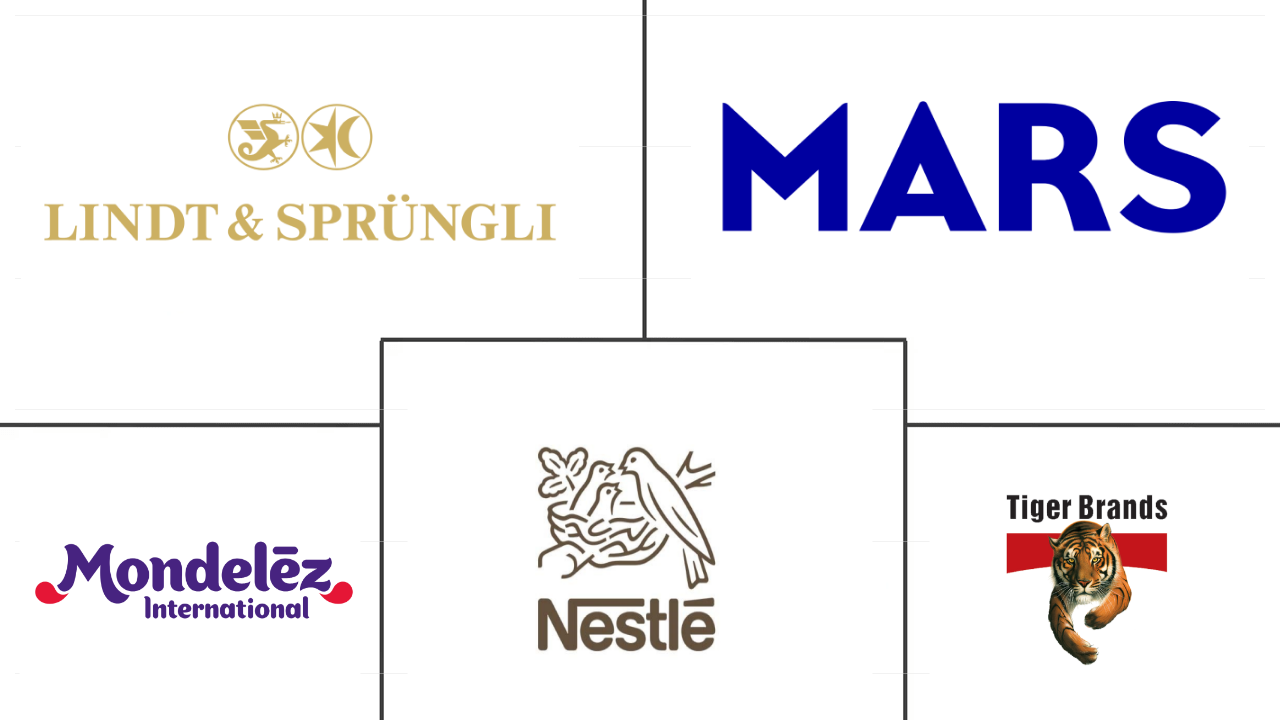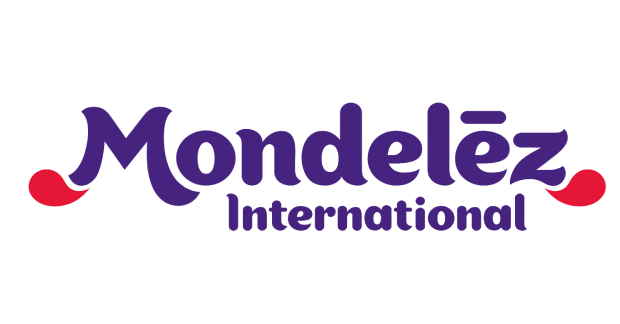Market Size of africa confectionery Industry
|
|
Study Period | 2018 - 2030 |
|
|
Market Size (2024) | USD 4.97 Billion |
|
|
Market Size (2030) | USD 7.69 Billion |
|
|
Largest Share by Distribution Channel | Convenience Store |
|
|
CAGR (2024 - 2030) | 7.57 % |
|
|
Largest Share by Country | South Africa |
Major Players |
||

|
||
|
*Disclaimer: Major Players sorted in no particular order |
Africa Confectionery Market Analysis
The Africa Confectionery Market size is estimated at 4.97 billion USD in 2024, and is expected to reach 7.69 billion USD by 2030, growing at a CAGR of 7.57% during the forecast period (2024-2030).
4.97 Billion
Market Size in 2024 (USD)
7.69 Billion
Market Size in 2030 (USD)
4.91 %
CAGR (2018-2023)
7.57 %
CAGR (2024-2030)
Largest Segment by Confections
44.21 %
value share, Sugar Confectionery, 2023
The innovative packaging concepts, with an increasing need for on-the-go snack options led by children and the young population in South America, led to segment's growth.
Largest Segment by Distribution Channel
46.44 %
value share, Convenience Store, 2023
The wider range of confectionery products offered by convenience stores propelled by impulse buying behavior is making it a major distribution channel in the market.
Fastest-growing Segment by Confections
10.39 %
Projected CAGR, Sugar Confectionery, 2024-2030
Factors such as surging population, rising disposable income, growing tourism industry, and increasing health concerns emerged as major factors for estimated segmental growth.
Fastest-growing Segment by Distribution Channel
11.17 %
Projected CAGR, Online Retail Store, 2024-2030
The ability to use online marketing tools to target new customers and website analysis tools to gain insight into specific consumers in the region are driving the segment.
Leading Market Player
22.97 %
market share, Mondelēz International Inc., 2022

An extensive range of product offerings and the company's main focus on taste and nutritional profiles based on consumer preferences support Mondelēz in the market studied.
Supermarkets and convenience stores account for over 80% of the share as nationwide store chains allow broader reach and easy access to multiple brands
- Supermarkets/hypermarkets have always maintained a strong lead in the sales of confectionery in the region. Chocolate is the most widely sold confection through supermarkets and hypermarkets, with a market volume share of 50.89% in 2022. Strategic positioning on the dedicated shelves for the chocolate confections influences impulse purchase behavior among potential consumers.
- Shoprite Holdings, Carrefour, and Massmart Holdings Limited are some of the leading grocery store operators in the region. A nationwide network of these operators allows easy access to both local and mainstream confectionery brands. As of 2023, Massmart operated around 287 stores across nine provinces of South Africa. Also, The Carrefour Group operates in Africa via franchises in 7 countries with local partners in more than 200 stores.
- Convenience stores are the second most widely preferred distribution channel for purchasing confectionery after supermarkets and hypermarkets. The volume of sales of confectionery through convenience stores is estimated to register an 18.96% volume share in 2024. The broader reach and easy access to private label brands drive the consumer preference for traditional grocery stores over other retail channels. Snack bar sales are estimated to grow at the highest CAGR through convenience stores to reach a sales value of USD 761.98 million in 2030.
- The online channel is projected to be the fastest-growing distribution channel for confectionery, with an anticipated CAGR of 6.13% in terms of value during the forecast period. The evolving role of online channels in grocery purchases is influenced by the increasing number of internet users. Internet penetration rate in Africa was 43% as of December 2021.
South Africa accounts for the largest market share due to the high consumption of chocolates, characterized by the increasing demand for premium and luxury brands
- South Africa was a dominant consumer of confectionery products in Africa as of 2022. Chocolates occupied the largest share in the market, with a value share of 78.98% as of 2023. Consumer demand is mostly propelled by the increasing demand for premium and luxury brands supported by the rising average level of income in the country, which is higher than the regional average. As of 2022, the median monthly salary in South Africa was USD 1,394 against a regional average of USD 758. This factor can also be supported by the expanding profile of premium chocolates in the country by global brands, such as Lindt and Ferrero Rocher, over the past decade. For instance, in 2023, Lindt launched a range of pioneering luxury selections of crafted vegan chocolate bars in the country.
- Egypt is the fastest-growing market in the region, with an anticipated CAGR of 6.61% by value during 2023-2030. Apart from domestic demand, the country receives numerous international travelers to explore its historical and cultural heritage. Chocolate and snack bars are considered useful snacking options while traveling as they provide a good amount of energy and calories to carry on with a full-day expedition. In 2023, Egypt received 11.7 million tourists, up from eight million in FY 2020-2021. In a consumer survey conducted in 2022, Galaxy, KitKat, and Cadbury brands repeatedly held the top positions for the most-liked chocolate confectionery brands in the country.
- Nigeria was a significant contributor to the regional market as of 2022 due to its cocoa-producing capacities. Ondo is the country's largest producer of cocoa (the primary confectionery ingredient), producing about 80,000 tons annually.
Africa Confectionery Industry Segmentation
Chocolate, Gums, Snack Bar, Sugar Confectionery are covered as segments by Confections. Convenience Store, Online Retail Store, Supermarket/Hypermarket, Others are covered as segments by Distribution Channel. Egypt, Nigeria, South Africa are covered as segments by Country.
- Supermarkets/hypermarkets have always maintained a strong lead in the sales of confectionery in the region. Chocolate is the most widely sold confection through supermarkets and hypermarkets, with a market volume share of 50.89% in 2022. Strategic positioning on the dedicated shelves for the chocolate confections influences impulse purchase behavior among potential consumers.
- Shoprite Holdings, Carrefour, and Massmart Holdings Limited are some of the leading grocery store operators in the region. A nationwide network of these operators allows easy access to both local and mainstream confectionery brands. As of 2023, Massmart operated around 287 stores across nine provinces of South Africa. Also, The Carrefour Group operates in Africa via franchises in 7 countries with local partners in more than 200 stores.
- Convenience stores are the second most widely preferred distribution channel for purchasing confectionery after supermarkets and hypermarkets. The volume of sales of confectionery through convenience stores is estimated to register an 18.96% volume share in 2024. The broader reach and easy access to private label brands drive the consumer preference for traditional grocery stores over other retail channels. Snack bar sales are estimated to grow at the highest CAGR through convenience stores to reach a sales value of USD 761.98 million in 2030.
- The online channel is projected to be the fastest-growing distribution channel for confectionery, with an anticipated CAGR of 6.13% in terms of value during the forecast period. The evolving role of online channels in grocery purchases is influenced by the increasing number of internet users. Internet penetration rate in Africa was 43% as of December 2021.
| Confections | |||||||||||
| |||||||||||
| |||||||||||
| |||||||||||
|
| Distribution Channel | |
| Convenience Store | |
| Online Retail Store | |
| Supermarket/Hypermarket | |
| Others |
| Country | |
| Egypt | |
| Nigeria | |
| South Africa | |
| Rest of Africa |
Africa Confectionery Market Size Summary
The Africa confectionery market is experiencing significant growth, driven by evolving consumer preferences and expanding distribution channels. Supermarkets and hypermarkets dominate the sales landscape, with chocolate being the most popular confectionery item, largely due to strategic shelf positioning that encourages impulse purchases. Leading grocery operators like Shoprite Holdings, Carrefour, and Massmart Holdings Limited play a crucial role in providing access to both local and international brands. Convenience stores also contribute significantly to sales, offering easy access to private label brands. The online channel is emerging as the fastest-growing distribution avenue, fueled by increasing internet penetration and changing consumer shopping habits. South Africa stands out as a major consumer market, with a strong demand for premium and luxury chocolate brands, supported by rising income levels and the presence of global brands.
The market is characterized by a diverse consumer base, with confectionery products being popular across various age groups and socio-economic segments. Brand loyalty is particularly strong among Gen Z and Millennial consumers, influencing their purchasing decisions. The market is fragmented, with major players like Chocoladefabriken Lindt & Sprüngli AG, Mars Incorporated, Mondelēz International Inc., Nestlé SA, and Tiger Brands holding significant shares. Recent product launches, such as vegan chocolate ranges and special edition flavors, reflect the industry's response to changing consumer tastes and dietary preferences. Countries like Egypt and Nigeria also contribute to the market's growth, with Egypt being the fastest-growing market due to its appeal to both domestic and international consumers.
Africa Confectionery Market Size - Table of Contents
-
1. MARKET SEGMENTATION (includes market size in Value in USD and Volume, Forecasts up to 2030 and analysis of growth prospects)
-
1.1 Confections
-
1.1.1 Chocolate
-
1.1.1.1 By Confectionery Variant
-
1.1.1.1.1 Dark Chocolate
-
1.1.1.1.2 Milk and White Chocolate
-
-
-
1.1.2 Gums
-
1.1.2.1 By Confectionery Variant
-
1.1.2.1.1 Bubble Gum
-
1.1.2.1.2 Chewing Gum
-
1.1.2.1.2.1 By Sugar Content
-
1.1.2.1.2.1.1 Sugar Chewing Gum
-
1.1.2.1.2.1.2 Sugar-free Chewing Gum
-
-
-
-
-
1.1.3 Snack Bar
-
1.1.3.1 By Confectionery Variant
-
1.1.3.1.1 Cereal Bar
-
1.1.3.1.2 Fruit & Nut Bar
-
1.1.3.1.3 Protein Bar
-
-
-
1.1.4 Sugar Confectionery
-
1.1.4.1 By Confectionery Variant
-
1.1.4.1.1 Hard Candy
-
1.1.4.1.2 Lollipops
-
1.1.4.1.3 Mints
-
1.1.4.1.4 Pastilles, Gummies, and Jellies
-
1.1.4.1.5 Toffees and Nougats
-
1.1.4.1.6 Others
-
-
-
-
1.2 Distribution Channel
-
1.2.1 Convenience Store
-
1.2.2 Online Retail Store
-
1.2.3 Supermarket/Hypermarket
-
1.2.4 Others
-
-
1.3 Country
-
1.3.1 Egypt
-
1.3.2 Nigeria
-
1.3.3 South Africa
-
1.3.4 Rest of Africa
-
-
Africa Confectionery Market Size FAQs
How big is the Africa Confectionery Market?
The Africa Confectionery Market size is expected to reach USD 4.97 billion in 2024 and grow at a CAGR of 7.57% to reach USD 7.69 billion by 2030.
What is the current Africa Confectionery Market size?
In 2024, the Africa Confectionery Market size is expected to reach USD 4.97 billion.

